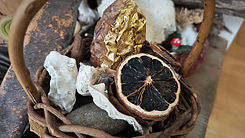
What is Sandplay
Therapy?
Sandplay Therapy is a therapeutic method developed by Dora Kalff and based on the psychological principles of C. G. Jung. Sandplay is a creative form of therapy in using imagination, “a concentrated extract of the life forces both physical and psychic” (C. G. Jung). It is characterized by the use of sand, water and miniatures in the creation of images within the “free and protected space” of the therapeutic relationship and the sand tray. A series of Sandplay images portrayed in the sand tray create an ongoing dialogue between the conscious and the unconscious aspects of the client’s psyche which activates a healing process and the development of personality.

NowTV interview with George Kwok CST on 11 September 2025
Sandplay Room Set-Up
沙遊房的設計
Major Elements
-
Sandtrays
-
Sand
-
Water
-
Figurines/miniatures
-
Shelves

Sandtrays
Dimension
-
28 1/2″ x 19 1/2″ x 3″ or 49.5 x 72 x 7 cm
-
Sky Blue bottom
-
Waterproof
The sandtray fills up the entire field of vision which allows one’s inner world to be reflected in the sandtray
It is optimal to have two sand trays available in the office, one with slightly damp sand, and one that remains dry at all times..
Sand
-
Natural Local Sand ✓
-
Beach Coral Sand ✓
-
Desert Sand ✓
-
Silicon Sand ✘
-
Dynamic (Moon) Sand ✘

Miniatures/ Figurines
-
People, Daily life
-
Nature, 5-Elements
-
Animals: Prehistoric, Wild, Kept
-
Civilization: Wars, Multicultural
-
Spiritual, Birth/Death, Mythical

People / Daily Life
-
Men/Women
-
Boys/Girls/Babies
-
Household
-
Furniture
-
Vehicles
-
Food

Nature / 5-Elements
-
Drift Wood
-
Trees/Flowers/Seeds
-
Stones/Marbles/Glass
-
Sun/Moon/Stars
-
Water/Fire/Metal

Animals
-
Prehistoric: Dinosaurs
-
Insects/Reptiles
-
Marine/Aquatic
-
Birds
-
Wild Animal
-
Domestic/Kept Animal
-
Pets
Civilization: Wars/Multiculture
-
Buildings/roads
-
Bridges/Gates/Fences
-
Soldiers/Tankers
-
Multicultural figures


Spiritual,Birth/Death, Mythical
-
Nativity/ Buddha/ Gods/Godesses
-
Mythical / Archetypal-Great Mother
-
Fairytales/ Cartoons
-
Birth/Death





Others / Clean-up tools
Colander
Sand toys
Clean-up tools
-
Bucket
-
Small broom
-
Sponge
-
Towels
How to Organise Shelves
from the bottom:
-
Nature: Wood, stones, seashell, metal, sun, moon, 5-elements
-
Prehistoric: Dinosaurs, aquatic animal: fish, sharks, dolphins…
-
Wild animal, domesticated animal, pets
-
Daily life: people, household, vehicles, food (eye level)
-
Civilization: wars, ancient civilization, super-heros
-
Top: Spiritual/Mythical: Nativity, gods and goddesses, mythical figures, life/death

2013 Survey on the development of sandplay therapy in Hong Kong
Summary of survey report:
The survey was conducted during the period of March 2013 till December 2013. A total of 21 eligible questionnaires were received and analyzed. The summary of the result was as follows.
Most participants utilizing sandplay therapy in this survey are falling in the age group of 31-50, at least achieving master level of education. Comparatively more participants worked under social service and private setting. Most users are female and none of them adapt a non-Jungian framework. These participants are the target group to be paid emphasis on sandplay training.
For the set-up, most users get two trays or more. Overall speaking, they get sufficient miniatures with essential categories. This agrees with the low perception on the difficulties in the set up. This may also relate to the work setting to allow the easier set up.
Only a few do sandplay therapy for children at 5 or under. Age 6-11 get most participants for using sandplay therapy. Over half participants using sandplay for the age group (three groups) between 5-39. No users are reported in the age group over 60 years old. This agree with the other therapies the participants would adopt, which quite a number of participants also use play therapy together with sandplay therapy. Again the coming workshops and trainings should be focus on these age groups (children, adolescent and adults before 40).
ISST trainings are more favored to the participants comparing to the non ISST ones. Since about half of the participants used sandplay therapy for only 1-3 years, it is suggested to provide some beginner trainings for these participants.
Play therapy, CBT, psychodynamic and family therapy are those who favored to use by the participants with sandplay therapy, and play therapy is the most popular one. Work setting significantly affected those who would use play therapy together with sandplay therapy. Moreover, the difficulties in engaging clients and the understanding of Jungian theory are the two highest scored. The years of practicing sandplay therapy don’t affect the perception of difficulties, but the age and framework they use do on the difficulties to set up the sandplay. The survey also indicated that the money, space for set-up, Jungian concepts and rarity of expertise in Hong Kong are the major difficulties. Hence it is recommended that for the coming training and activities, HKSTA should consider more on the experience sharing of the trainer to engage clients (beware of the difference between clinical psychologists and counselors as they are significantly different in perceiving the difficulty), facilitating their understanding of Jungian theory and the associative use with play therapy, CBT, family therapy or psychodynamic.
For the helpfulness, it is reported that sandplay therapy is fairly helpful for the users in their practice. It should be noticed that the age of the users and framework they adopted significantly affect the perception on the helpfulness. The case nature of depression, anxiety, trauma and children as clients are those who are reported to be helpful by using sandplay therapy.
The development of sandplay therapy is under development and in an initial state, still takes time. The participants also expressed their needs, mainly the lack of qualified trainers, money, space for set-up and Jungian concepts, especially structured training.
Prepared by : Kwok Kar Kin, George in 2014